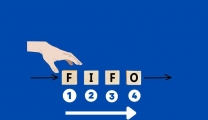The Flaw of Fixed Scope, Fixed Date Commitment
Let’s break down this statement.
Delivering “all of the 10 items by next Thursday” means that you are fixing both the scope and the end date. And you should never do that.
Then, finishing “these exact 10 items” means that you assume there won’t be any additional work coming in between, the priority of your tasks will stay the same and there won’t be any issues or emergencies popping up along the way. Can you really commit to that?
The future is not deterministic. There is no model that provides a 100% certainty that something will happen in the future. There are always multiple outcomes that may occur. By Thursday, you may deliver 10 items, or a little bit less or perhaps a little bit more.
The only thing you can do to get closer to what will actually happen is to manage the uncertain and unknown effectively. So, how can we get there?
Why Forecasting Is a Better Idea
Instead of committing to a fixed date and scope, provide a forecast.
A forecast looks like this: “We can deliver 10 items by next Thursday with an 85% probability of hitting that target.”

Let’s Dig Into the Numbers
This team can deliver at least 5 items per release. This is their absolute minimum. They guarantee that they will deliver at least 5 items and that goal comes with a 95% certainty that this will happen.
Then, there is an 85% chance that they will deliver at least 10 items and a 70% chance that they will finish more than 12 items. The chance that they will complete 14 items drops down to about 50%.
Even though this team managed to finish 24 items in one of their previous releases, it is unlikely that they will be able to complete that much work consistently. The probability that comes with this goal is less than 30%. If they go with that number, it is very likely that some of the work will be rescheduled for the next iteration.
If the work is complex, there are lots of unknowns and you expect obstacles along the way, then go with the 95th percentile to reduce the risk of failure. Schedule 5 items instead. You will probably deliver more, but not less than 5 items and that promise comes with very high confidence that you’ll keep it.
That’s how you manage the uncertain and unknown in an effective way.
The question of “When will this be done?” is not that interesting anymore. The charts already provide that answer for you. The question now is, how much risk are you willing to take?
-(1920-1280-px)-(3).png)
We’re mitigating the risk of failure by choosing higher percentiles to work with.
The Only Prerequisite to Making Any Approach to Forecasting Work
Now, you may wonder, does this approach work if you don’t have items of the same size? It certainly does, and here is our 5-step guide to managing items of different sizes that proves it.
The size and nature of your work items don’t affect the reliability of the forecasts. The only prerequisite to making this (and any other approach) work is to optimize your delivery workflow for predictability.
If the work you’re about to handle is easy, you’ve done this before, you don’t expect any challenges along the way and most importantly, you maintain a stable delivery system, then, by all means, go with a lower percentile. Just keep in mind, the lower the probability of achieving your goals, the higher the chance of failure.












Replies to This Discussion